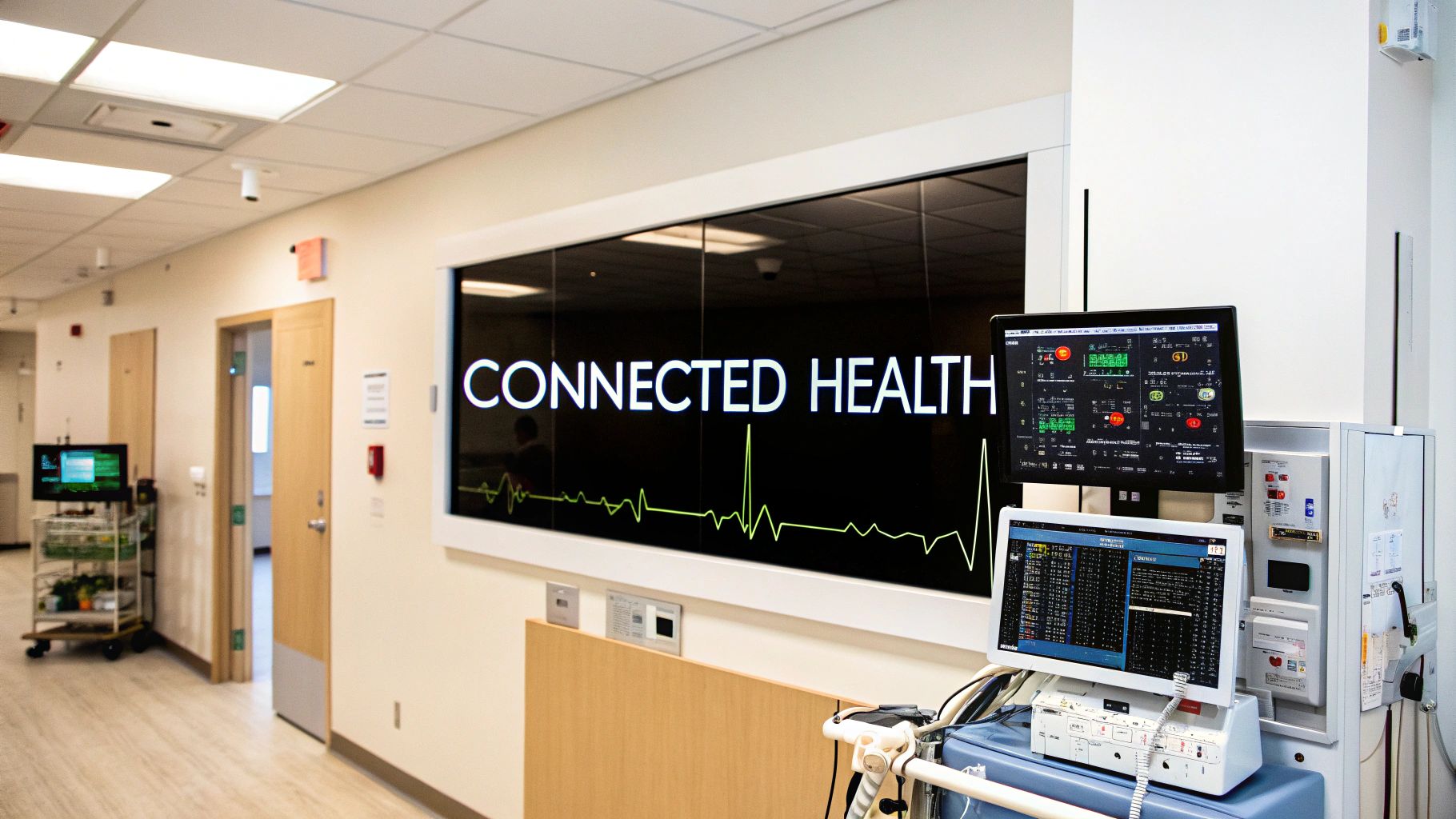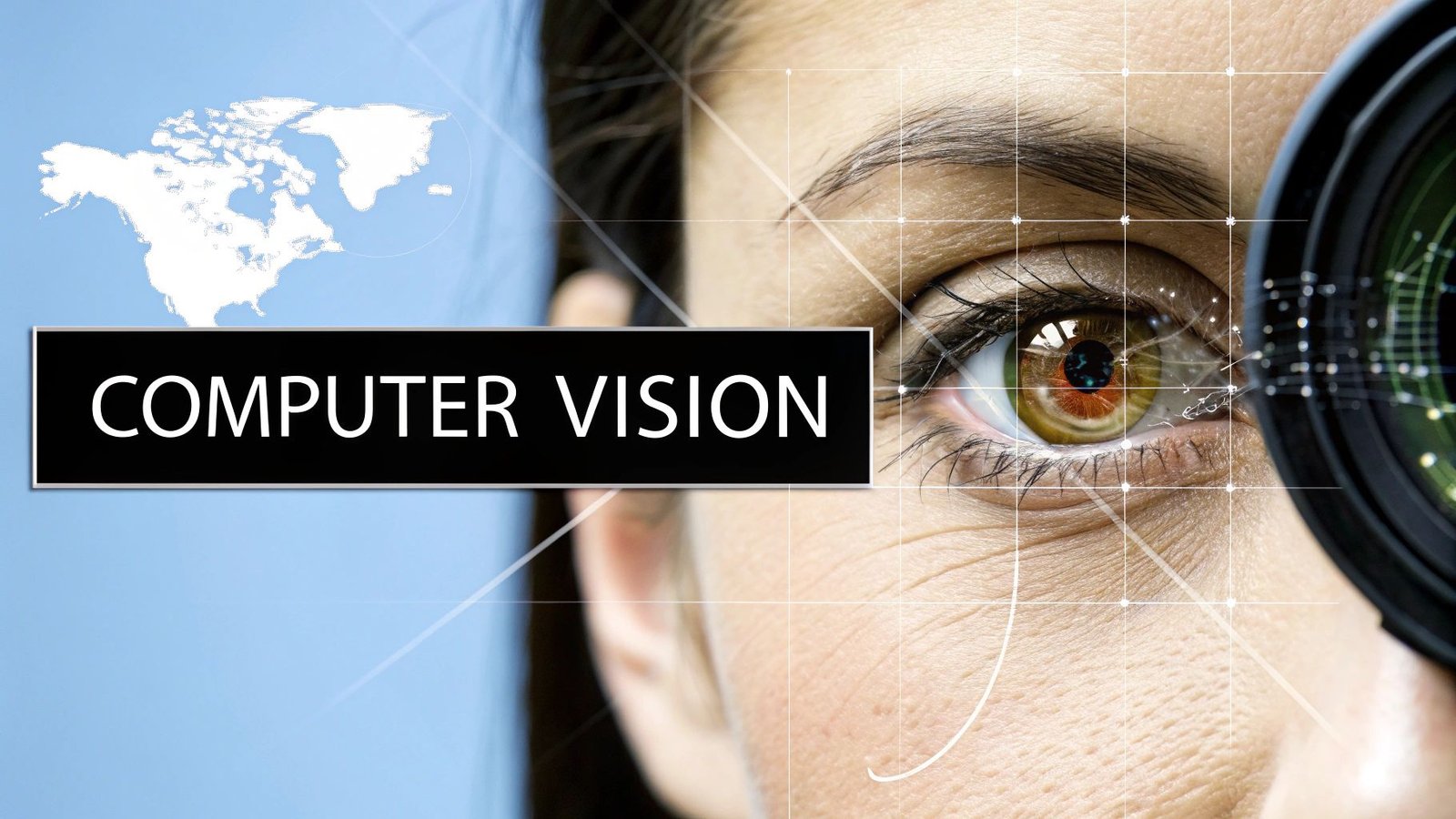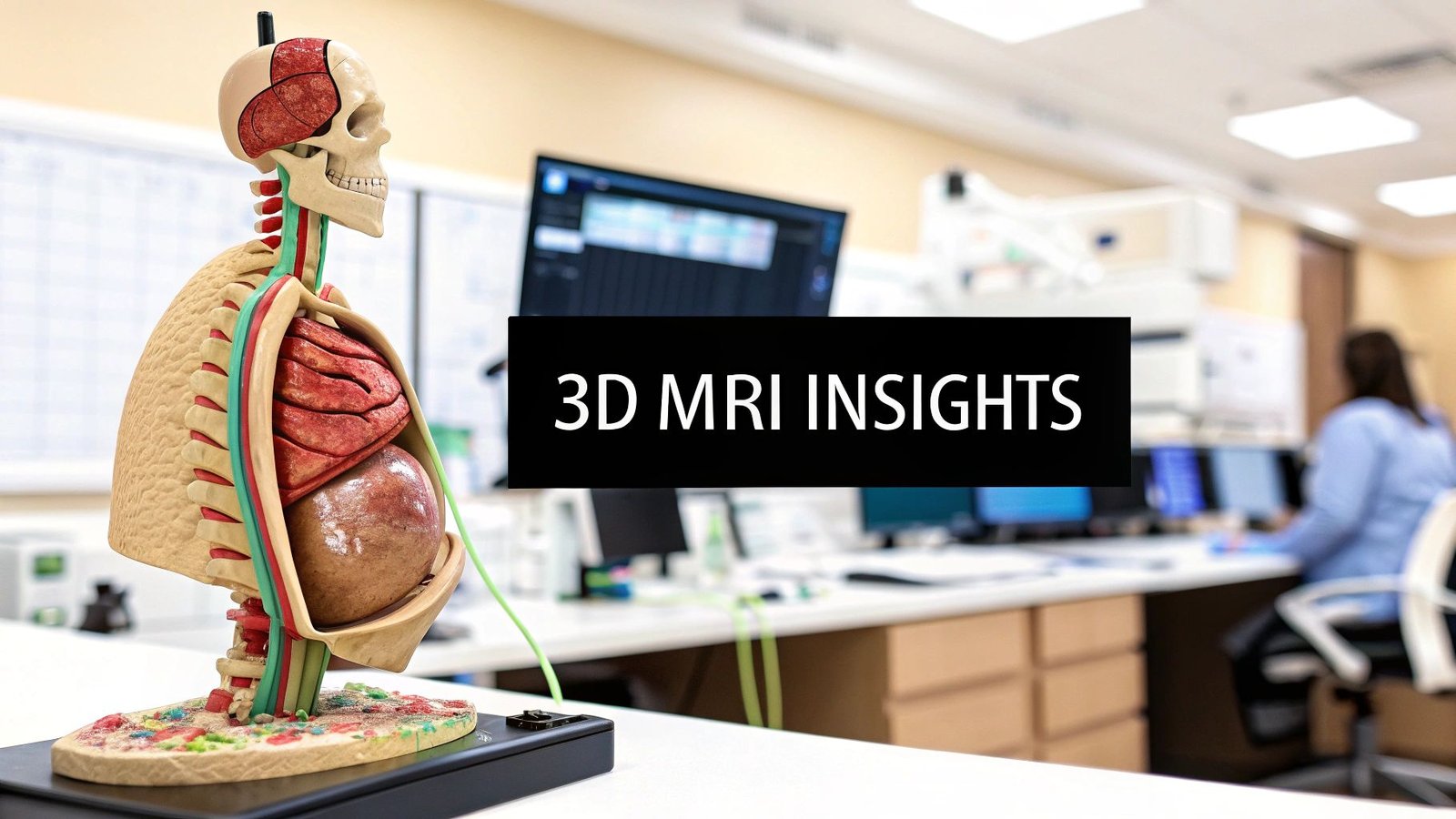Connecting the Dots in Healthcare: A Look at Top Interoperability Solutions
Frustrated with data silos hindering patient care and operational efficiency? This listicle examines eight leading healthcare interoperability solutions to help you choose the right tools for your organization in 2025. We'll cover key features, pros, and cons of each platform, focusing on how these solutions solve data exchange challenges. Explore top options including Epic, Cerner, Allscripts, NextGen, Microsoft, Amazon, Intersystems, and Redox, and find the best healthcare interoperability solutions for your needs.
1. Epic MyChart and Care Everywhere
Epic MyChart and Care Everywhere together represent a dominant force in healthcare interoperability solutions, offering a comprehensive platform for secure health information exchange. While often viewed as two separate entities, they function as a cohesive unit. Care Everywhere, the backbone of Epic's interoperability strategy, facilitates data exchange between different healthcare systems, both those using Epic and those using other EHRs. MyChart, the patient portal component, empowers patients with access to their medical records and communication tools, enhancing patient engagement and fostering a more collaborative approach to care. This combined approach makes Epic a significant player in addressing the challenges of fragmented healthcare data. Specifically, for organizations seeking a robust solution with a large established network, Epic provides a compelling offering.

Care Everywhere leverages industry standards like FHIR R4 APIs to enable real-time clinical data exchange, encompassing a wide range of information, including patient demographics, medical history, lab results, medications, and immunizations. This real-time access is crucial for coordinated care, particularly in emergency situations or when patients see specialists outside their primary healthcare system. For medical device manufacturers and healthcare technology companies, this interoperability opens doors for integrating their products and services into the Epic ecosystem, potentially reaching a vast network of providers and patients.
MyChart's patient portal integration further strengthens Epic's interoperability offering. Patients can access their health information from multiple providers using a single portal, streamlining communication and promoting patient ownership of their health data. Features like appointment scheduling, prescription refills, and secure messaging with providers contribute to increased patient engagement and satisfaction. This is particularly relevant for medical researchers and scientists who can leverage patient-reported data gathered through MyChart for research purposes, with appropriate consent and privacy safeguards.
For hospital and clinic IT departments, implementing Epic offers both advantages and challenges. The extensive provider network coverage and proven track record with large health systems are strong selling points. Epic’s comprehensive EHR integration simplifies workflow and data management. However, the high implementation costs, complex customization requirements, and potential for vendor lock-in are significant considerations. While pricing information is not publicly available, industry estimates place Epic implementations in the millions of dollars, varying based on the size and complexity of the organization. Technical requirements include robust IT infrastructure, dedicated personnel for implementation and maintenance, and ongoing training for staff.
While Epic promotes interoperability with non-Epic systems, it's widely acknowledged that connections between Epic instances are generally smoother and more feature-rich. This "Epic-to-Epic" bias can be a concern for organizations interacting with a diverse network of healthcare providers using various EHR systems. Academic institutions and medtech startups should carefully evaluate this aspect, considering the interoperability needs within their specific ecosystems. DICOM communication and transfer companies might face integration challenges due to the complexities of handling medical images within the Epic environment, requiring careful planning and coordination.
Some implementation tips for organizations considering Epic include:
- Thorough Needs Assessment: Clearly define your interoperability goals and requirements before embarking on an Epic implementation.
- Dedicated Project Team: Assemble a team of internal stakeholders and Epic experts to manage the implementation process effectively.
- Extensive Training: Ensure all staff members receive comprehensive training on using the Epic system and leveraging its interoperability features.
- Ongoing Optimization: Continuously monitor and optimize the system after implementation to maximize interoperability and address any emerging challenges.
Despite the potential drawbacks, Epic MyChart and Care Everywhere remain a leading healthcare interoperability solution. Its extensive network, robust features, and patient engagement tools offer compelling benefits for organizations seeking to improve care coordination and patient access to information. For a deeper dive into Epic's offerings, visit their website: https://www.epic.com
2. Cerner HealtheLife and CommonWell: A Comprehensive Interoperability Solution
Oracle Cerner's HealtheLife and CommonWell combination offers a robust approach to healthcare interoperability solutions, addressing the critical need for seamless data exchange in modern healthcare. This integrated solution combines patient engagement functionalities through the HealtheLife patient portal with nationwide health information exchange (HIE) capabilities via the CommonWell Health Alliance. This powerful synergy enables providers to access a more complete picture of patient data, aggregated from multiple sources, ultimately contributing to improved care coordination and informed clinical decision-making. It also supports population health management initiatives by providing insights into broader health trends and facilitating proactive interventions.
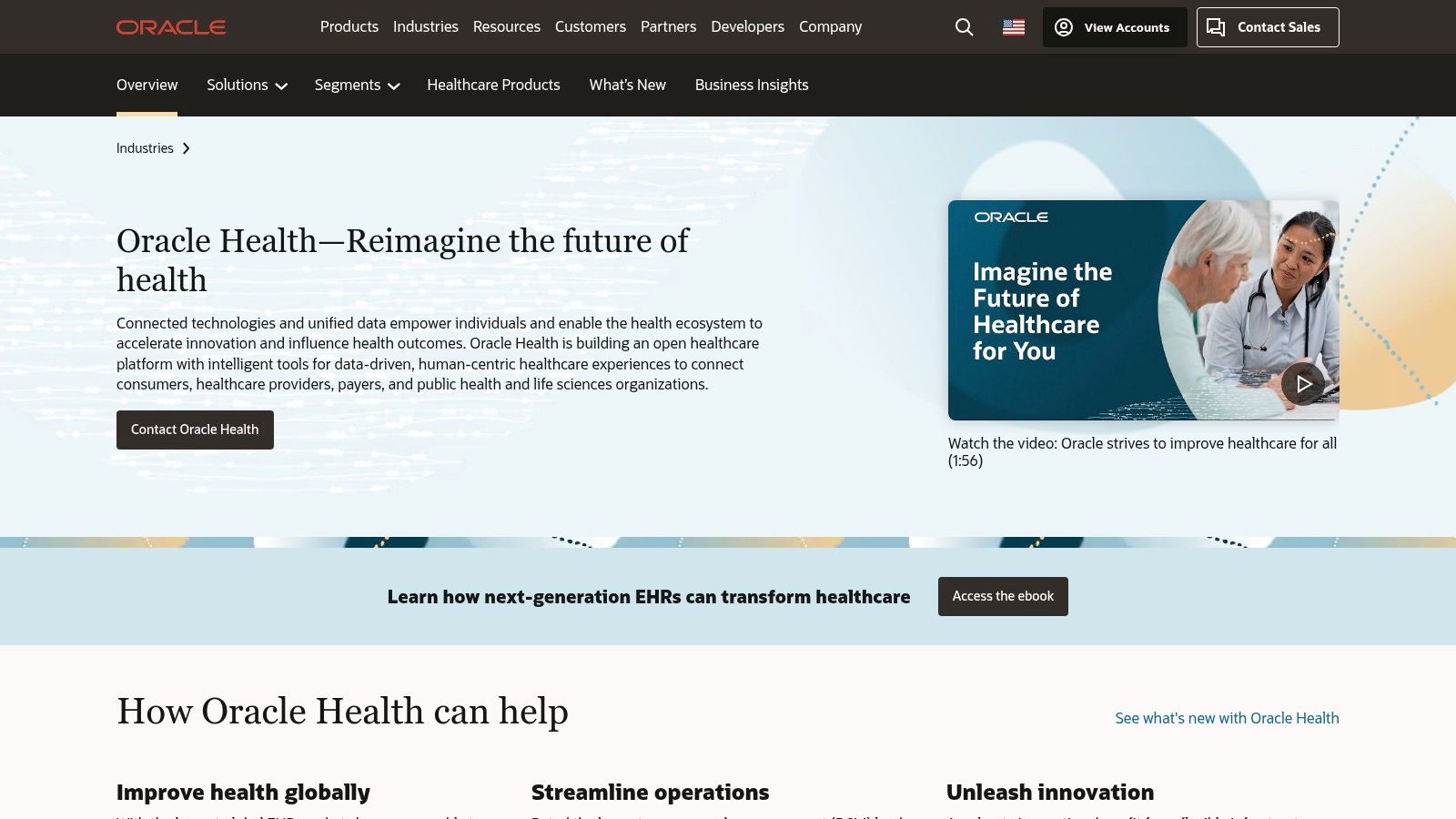
Cerner HealtheLife and CommonWell distinguishes itself through its focus on comprehensive data integration and patient empowerment. The multi-vendor data aggregation feature breaks down traditional data silos, allowing clinicians to access patient records from different EHR systems, hospitals, and clinics participating in the CommonWell network. This interconnectedness streamlines workflows and eliminates the need for time-consuming manual data requests. Patients also benefit significantly from the HealtheLife portal, gaining access to their medical records, scheduling appointments, communicating with providers, and actively managing their health information.
For medical device manufacturers and healthcare technology companies, Cerner's solution offers a valuable platform for integration. By leveraging the CommonWell network, devices can seamlessly share data with participating healthcare providers, enhancing the value proposition of these technologies and contributing to a more holistic understanding of patient health. Researchers and academic institutions can also benefit from the aggregated data available through this platform, facilitating larger-scale studies and analysis of population health trends. This data-driven approach enables researchers to identify potential areas for improvement in healthcare delivery and develop more effective interventions.
Hospital and clinic IT departments looking for comprehensive interoperability solutions will find the scalable cloud infrastructure of Cerner HealtheLife and CommonWell appealing. The cloud-based architecture simplifies deployment and maintenance, reducing the burden on internal IT resources. However, integration with existing legacy systems can present a challenge and require significant planning and resources. While the platform offers robust analytics and population health tools, customization options are somewhat limited.
Features:
- Multi-vendor data aggregation: Access patient data from various EHR systems and healthcare providers.
- Population health analytics: Analyze aggregated patient data to identify trends and inform population health strategies.
- Patient identity matching: Accurately match patient records across different systems to ensure data integrity.
- Cloud-based architecture: Simplified deployment and maintenance with a scalable infrastructure.
- Mobile health record access: Empower patients to access and manage their health information through mobile devices.
Pros:
- Strong analytics capabilities: Provides comprehensive tools for analyzing patient data and identifying actionable insights.
- Broad vendor collaboration through CommonWell: Facilitates seamless data exchange between disparate systems.
- Scalable cloud infrastructure: Reduces IT burden and supports growth.
- Integrated population health tools: Supports proactive population health management initiatives.
Cons:
- Integration complexity with legacy systems: Requires significant planning and resources for integration with existing systems.
- Requires significant IT resources: Despite the cloud-based architecture, managing the system effectively requires dedicated IT support.
- Limited customization options: May not fully address the specific needs of all organizations.
- Dependency on CommonWell network participation: The system's effectiveness relies on the participation of other healthcare providers in the CommonWell network.
Unfortunately, specific pricing and technical requirements for Cerner HealtheLife and CommonWell are not publicly available and typically require contacting Oracle Cerner directly. For implementation, it's crucial to thoroughly assess existing IT infrastructure and plan for integration with legacy systems. Collaboration with Cerner's implementation team is essential for a smooth transition. While alternatives like Epic's Care Everywhere and athenahealth's network exist, Cerner's solution offers a strong combination of patient engagement and broad interoperability through the CommonWell Alliance, making it a worthwhile consideration for organizations seeking comprehensive healthcare interoperability solutions. For more information, visit the Oracle Cerner Health website.
3. Allscripts dbMotion
Allscripts dbMotion stands as a robust healthcare interoperability solution, offering a comprehensive health information exchange (HIE) platform. Its primary function is aggregating clinical data from disparate sources, transforming fragmented information into a unified, holistic patient view. This proves invaluable for healthcare providers seeking to enhance care coordination, streamline clinical workflows, and ultimately, improve patient outcomes. dbMotion is particularly adept at facilitating real-time clinical collaboration across diverse healthcare organizations and electronic health record (EHR) systems, making it a key player in the pursuit of seamless healthcare interoperability solutions. This makes it a vital tool for organizations seeking to break down data silos and promote a more connected healthcare ecosystem.
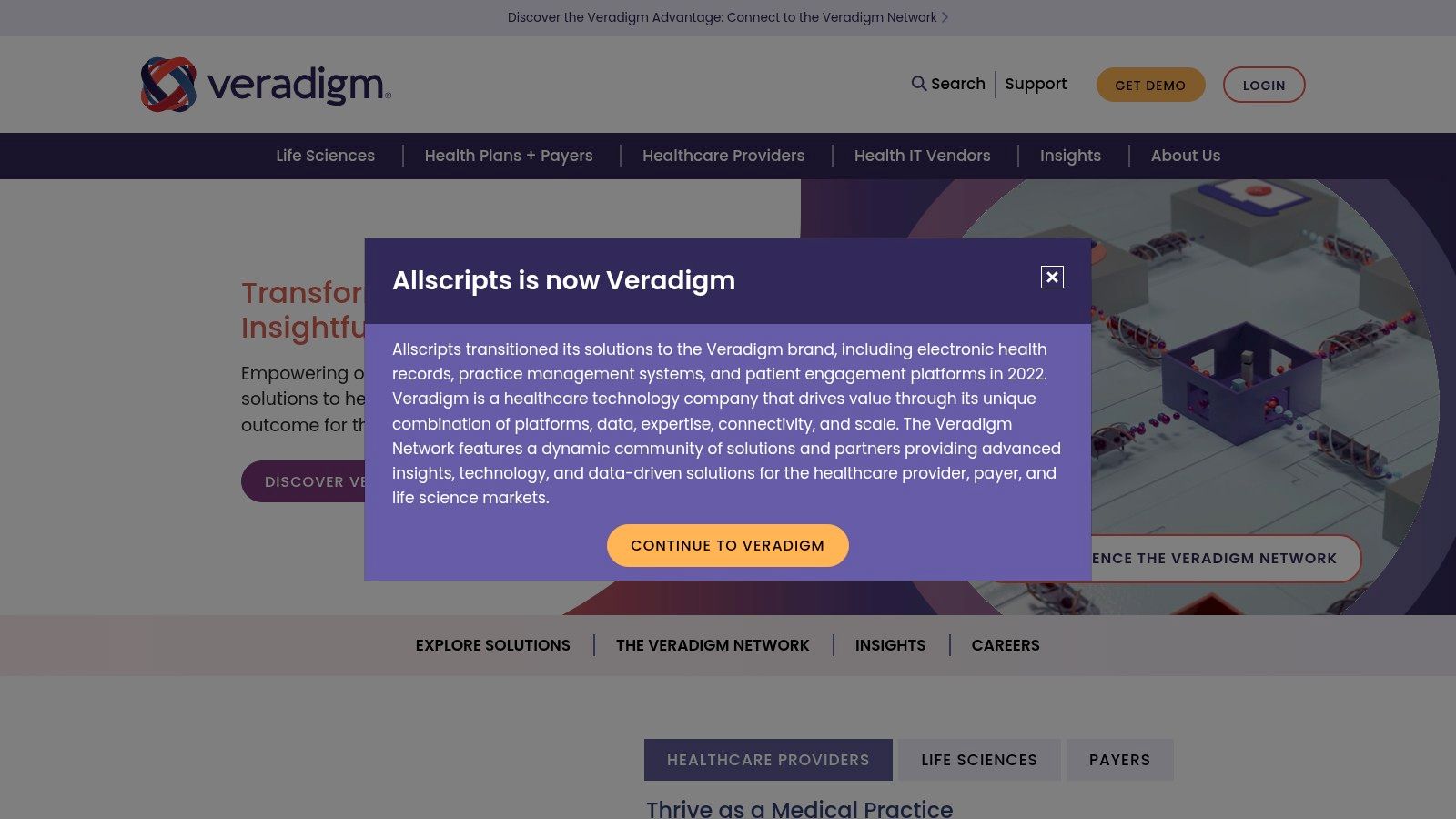
A key strength of dbMotion lies in its vendor-agnostic approach. This interoperability allows it to connect with a wide range of EHR systems and other healthcare IT solutions, regardless of the vendor. This flexibility is crucial in today's complex healthcare landscape, where organizations often rely on a mix of technologies from different vendors. For our target audience, including medical device manufacturers, healthcare technology companies, and hospital IT departments, this vendor-agnostic approach simplifies integration and expands the potential reach of their own solutions.
dbMotion boasts a suite of powerful features designed to enhance interoperability and improve patient care. Its real-time clinical viewer provides authorized clinicians with instant access to a patient’s comprehensive medical history, regardless of where the data originates. This feature alone can significantly improve decision-making, particularly in emergency situations. The platform’s multi-source data aggregation capabilities pull together patient information from various sources, including hospitals, clinics, labs, and pharmacies, creating a single, consolidated patient record. This comprehensive view eliminates the need to manually search for information across different systems, saving valuable time and reducing the risk of errors. Clinical workflow integration further streamlines processes by embedding relevant patient data directly into existing clinical workflows. This minimizes disruptions and allows clinicians to access critical information without leaving their primary EHR system.
Advanced patient matching algorithms ensure accurate identification of patients across different data sources, even in the presence of variations in names, addresses, or other identifying information. This is critical for preventing duplicate records and ensuring that clinicians have access to the correct patient information. Furthermore, dbMotion's care gap identification feature helps providers identify potential gaps in patient care, such as missed appointments or overdue screenings. This proactive approach can improve patient adherence to treatment plans and contribute to better health outcomes.
While dbMotion offers significant advantages, it's crucial to consider its potential drawbacks. Implementing dbMotion can be complex and require significant upfront investment. Extensive data mapping is often necessary to ensure seamless data exchange between different systems. Furthermore, while dbMotion excels in clinical data exchange, its patient engagement features are somewhat limited compared to some other solutions on the market. Ongoing maintenance and support are also required, adding to the overall cost of ownership.
Unfortunately, specific pricing and technical requirements for dbMotion are not readily available publicly. Potential users will need to contact Allscripts directly for detailed information tailored to their specific needs.
Comparing dbMotion with other similar tools like InterSystems HealthShare or Orion Health Rhapsody reveals that each solution offers a slightly different approach to healthcare interoperability. While HealthShare focuses on data integration and analytics, Rhapsody emphasizes population health management. dbMotion's strength lies in its real-time clinical data exchange and workflow integration capabilities, making it a particularly strong choice for organizations prioritizing care coordination and clinical collaboration.
For organizations considering implementing dbMotion, thorough planning and preparation are essential. Engage with Allscripts early in the process to understand the specific requirements and develop a customized implementation plan. Prioritize data mapping and ensure that all relevant systems are compatible with the platform. Training staff on the new system is also crucial for maximizing its effectiveness.
In conclusion, Allscripts dbMotion offers a powerful solution for organizations seeking to improve healthcare interoperability. Its comprehensive features, vendor-agnostic approach, and strong clinical workflow integration make it a valuable tool for enhancing care coordination and improving patient outcomes. While implementation complexity and ongoing maintenance requirements should be considered, the potential benefits of a unified patient view and streamlined clinical workflows make dbMotion a worthy contender in the realm of healthcare interoperability solutions. You can explore further details on the Allscripts website: https://www.allscripts.com
4. NextGen Mirth Connect
NextGen Mirth Connect stands as a prominent open-source healthcare integration engine, specifically designed to facilitate seamless data exchange between disparate healthcare systems. This powerful tool offers a robust platform for HL7 message processing, data transformation, and workflow automation, making it a valuable asset in today’s interconnected healthcare landscape. As a key player in healthcare interoperability solutions, Mirth Connect empowers organizations to overcome the challenges of data silos and achieve true interoperability. Its versatility and adaptability make it particularly relevant for medical device manufacturers, healthcare technology companies, medical researchers, hospital IT departments, and academic institutions, all striving to improve patient care and advance medical knowledge through efficient data sharing.
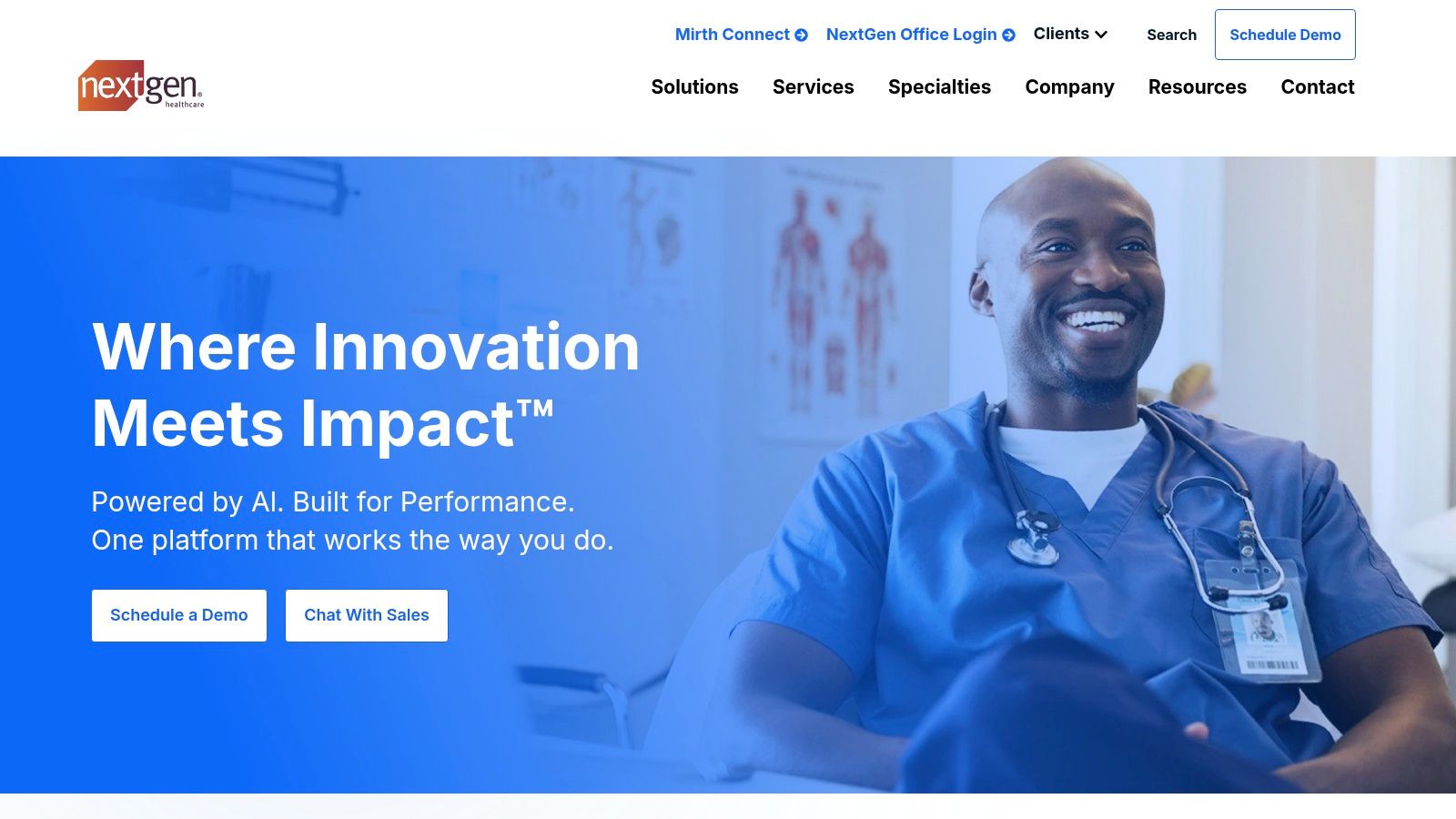
One of the key strengths of Mirth Connect lies in its comprehensive support for HL7 FHIR (Fast Healthcare Interoperability Resources). This modern standard simplifies the exchange of healthcare data, enabling greater interoperability between different systems. Mirth Connect's visual interface designer empowers users to create and manage complex integration workflows with ease, minimizing the need for extensive coding. This feature streamlines the development process and allows for quicker deployment of interoperability solutions.
Mirth Connect's multi-protocol connectivity ensures compatibility with a wide range of communication standards used in healthcare, including TCP/IP, HTTP, and FTP. This flexibility enables seamless integration with various systems, regardless of their underlying architecture. The real-time monitoring dashboard provides valuable insights into message flow, system performance, and potential errors, allowing for proactive management and troubleshooting. This ensures data integrity and facilitates continuous optimization of integration processes.
The extensive transformation capabilities of Mirth Connect allow users to manipulate and convert data between different formats, ensuring compatibility between systems with varying data structures. This robust functionality is essential for integrating legacy systems with newer technologies and facilitating data exchange within complex healthcare environments.
Practical Applications and Use Cases:
- Connecting Electronic Health Records (EHRs): Mirth Connect can be used to bridge the gap between disparate EHR systems, enabling seamless patient data exchange between hospitals, clinics, and other healthcare providers.
- Integrating Medical Devices: Mirth Connect can facilitate the integration of medical devices with hospital information systems, allowing for real-time data capture and analysis for improved patient monitoring and diagnosis. This is particularly relevant for medical device manufacturers and medtech startups looking for efficient DICOM communication and transfer solutions.
- Enabling Research Data Sharing: Researchers can utilize Mirth Connect to aggregate and analyze data from multiple sources, accelerating the pace of medical discovery and innovation. Academic institutions and medical researchers benefit from its open-source nature and customizability.
- Building Healthcare APIs: Mirth Connect can serve as a foundation for building secure and scalable healthcare APIs, enabling third-party applications to access and interact with healthcare data in a controlled manner.
Pricing and Technical Requirements:
While the open-source version of Mirth Connect is free to use, NextGen Healthcare offers commercial versions with additional features and vendor support. The technical requirements vary depending on the specific implementation, but generally involve a server environment running Java and a database for message storage.
Comparison with Similar Tools:
Mirth Connect often gets compared to other integration engines like MuleSoft and Intersystems Ensemble. While these tools offer similar functionalities, Mirth Connect's open-source nature and strong community support make it a compelling choice for organizations seeking cost-effective and highly customizable solutions.
Implementation and Setup Tips:
- Start with a clear understanding of your integration needs: Define the specific systems you need to connect, the data you need to exchange, and the desired workflows.
- Leverage the Mirth Connect community: The active community forum and online resources can provide valuable support and guidance during implementation.
- Invest in training: While the visual interface simplifies development, training on Mirth Connect’s functionalities can significantly expedite the implementation process.
- Consider the long-term maintenance: While the open-source version is cost-effective upfront, factor in the ongoing maintenance and support needs.
Pros:
- Open-source and cost-effective
- Highly customizable
- Strong community support
- Supports multiple data formats
Cons:
- Requires technical expertise
- Limited vendor support for open-source version
- Complex initial setup
- Ongoing maintenance needs
Website: https://www.nextgen.com
NextGen Mirth Connect offers a powerful and versatile solution for addressing the complex challenges of healthcare interoperability. Its open-source nature, combined with its rich feature set and active community, makes it an ideal choice for organizations seeking to build robust and scalable healthcare integration solutions.
5. Microsoft Cloud for Healthcare
Microsoft Cloud for Healthcare is a comprehensive platform designed to address the growing need for interoperability in the healthcare industry. It leverages the power of Microsoft Azure and integrates healthcare-specific solutions to enable seamless data exchange and collaboration. This platform offers a suite of tools, including the Azure FHIR service, Teams for Healthcare, and AI-powered health insights, aiming to streamline workflows, enhance patient care, and improve operational efficiency across healthcare organizations. Its focus on facilitating interoperability makes it a crucial solution for organizations looking to break down data silos and improve communication within the healthcare ecosystem.
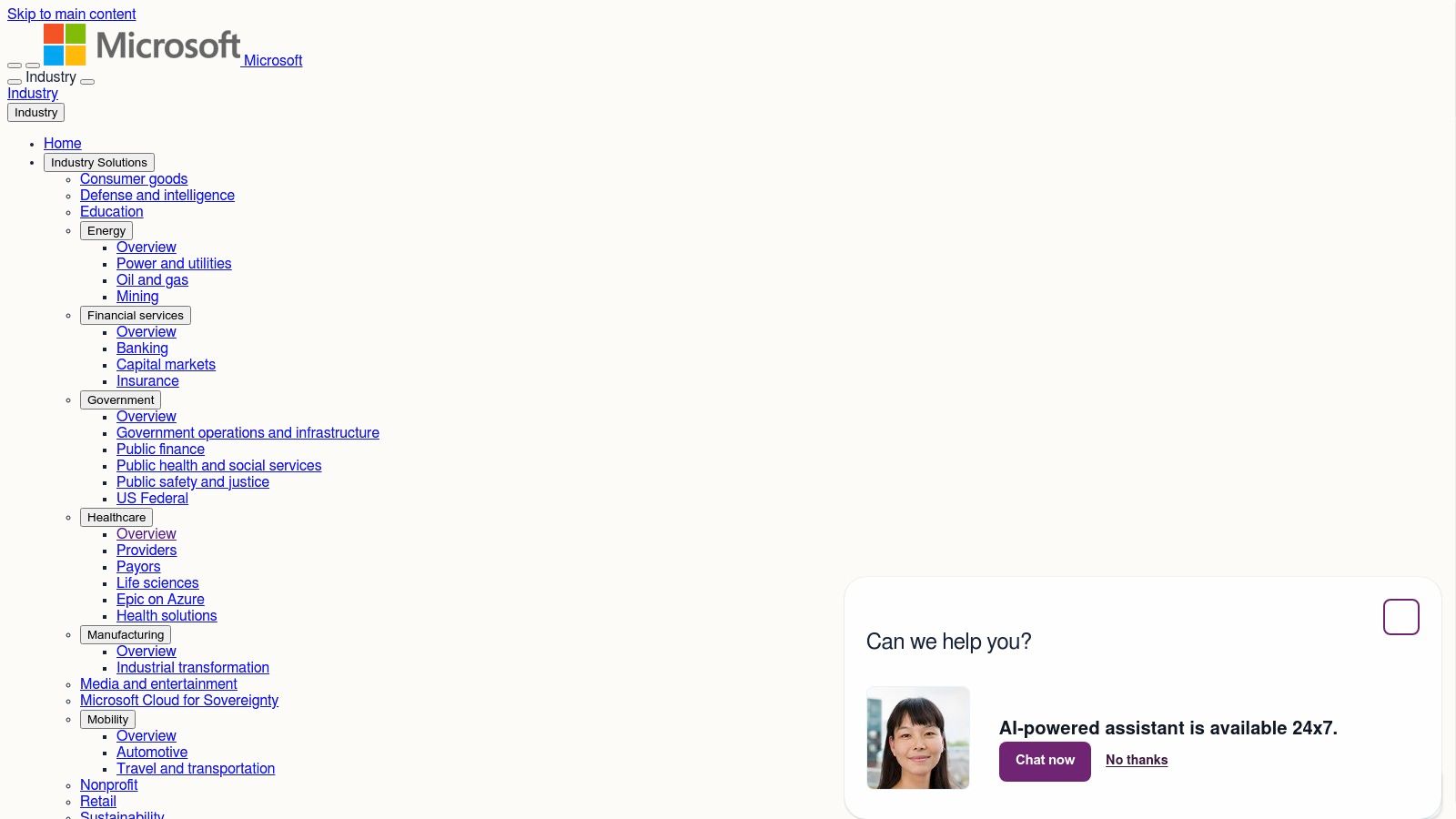
For medical device manufacturers, Microsoft Cloud for Healthcare provides a robust infrastructure for securely collecting and analyzing device data. This data can be used to improve device performance, develop new features, and even offer predictive maintenance. The platform’s adherence to FHIR standards ensures interoperability, allowing these devices to seamlessly integrate with existing hospital systems and electronic health records (EHRs). Healthcare technology companies can leverage the platform's scalability and security to build and deploy innovative solutions, while researchers and scientists can utilize the AI-powered health insights to analyze large datasets and accelerate medical discoveries. Hospital and clinic IT departments benefit from streamlined workflows, improved care coordination, and enhanced telehealth capabilities. Academic institutions can use the platform for educational purposes, training future healthcare professionals on the latest technologies and interoperability standards. Medtech startups gain access to enterprise-grade tools and resources, accelerating their development and deployment cycles. Even companies specializing in DICOM communication and transfer can leverage the platform's capabilities to enhance image sharing and analysis within a secure and compliant environment.
A key component of Microsoft Cloud for Healthcare is the Azure FHIR service. FHIR (Fast Healthcare Interoperability Resources) is a standard for exchanging healthcare information electronically. The Azure FHIR service provides a managed, compliant, and scalable environment for storing, managing, and querying FHIR data. This allows healthcare organizations to easily exchange data with other systems that also adhere to the FHIR standard, fostering true interoperability. Furthermore, the integration of Teams for Healthcare facilitates secure communication and collaboration among care teams. Features like virtual visits and care coordination dashboards enable efficient and streamlined workflows. The platform also includes AI-powered tools that can analyze patient data to generate actionable insights, supporting clinical decision-making and personalized care.
Microsoft Cloud for Healthcare’s enterprise-grade security and compliance features are a major advantage. The platform adheres to industry regulations like HIPAA and GDPR, ensuring the privacy and security of patient data. Seamless integration with the existing Microsoft ecosystem is another significant benefit, especially for organizations already utilizing Microsoft products. This integration simplifies deployment and streamlines workflows. Moreover, the platform benefits from the scalability of the Azure cloud infrastructure, allowing organizations to adapt to changing needs and growing data volumes. The built-in AI and analytics capabilities provide valuable insights that can drive improvements in patient care and operational efficiency.
However, the platform also has some drawbacks. It requires a commitment to the Microsoft technology stack, which may not be ideal for organizations using other platforms. The pricing structure can be complex and requires careful consideration. There is a learning curve for organizations not already familiar with the Microsoft environment. Finally, the platform's reliance on cloud connectivity means that disruptions in internet access can impact functionality.
Implementation involves assessing existing systems, migrating data to the Azure cloud, configuring the FHIR service, and training staff on the new platform. Microsoft offers extensive documentation and support resources to guide users through this process. While specific pricing details are not readily available and require consultation with Microsoft, it generally follows a consumption-based model where costs are tied to usage and storage.
Compared to other healthcare interoperability solutions, Microsoft Cloud for Healthcare stands out with its comprehensive approach. While other platforms may focus on specific areas like data exchange or telehealth, Microsoft offers an integrated suite of tools that addresses various interoperability challenges. Its robust security and compliance framework, combined with the power of the Azure cloud, make it a compelling choice for organizations seeking a secure and scalable solution. The platform's focus on AI and analytics further differentiates it, providing opportunities for data-driven insights and innovation.
For organizations seeking a comprehensive and scalable healthcare interoperability solution anchored in a familiar ecosystem, Microsoft Cloud for Healthcare is a strong contender. Its strengths lie in its comprehensive features, robust security, and seamless integration with the Microsoft ecosystem. However, organizations should carefully evaluate their existing infrastructure, budget, and technical expertise before committing to this platform. Further information can be found on the official website: https://www.microsoft.com/en-us/industry/health.
6. Amazon HealthLake
Achieving true healthcare interoperability is a complex undertaking, requiring solutions that can seamlessly manage, analyze, and share health data across different systems. Amazon HealthLake emerges as a powerful contender in this space, offering a robust and scalable platform designed to address the challenges of healthcare data interoperability. This HIPAA-eligible service from AWS empowers healthcare organizations to store, transform, and analyze health data at a massive scale, facilitating better insights and collaboration.
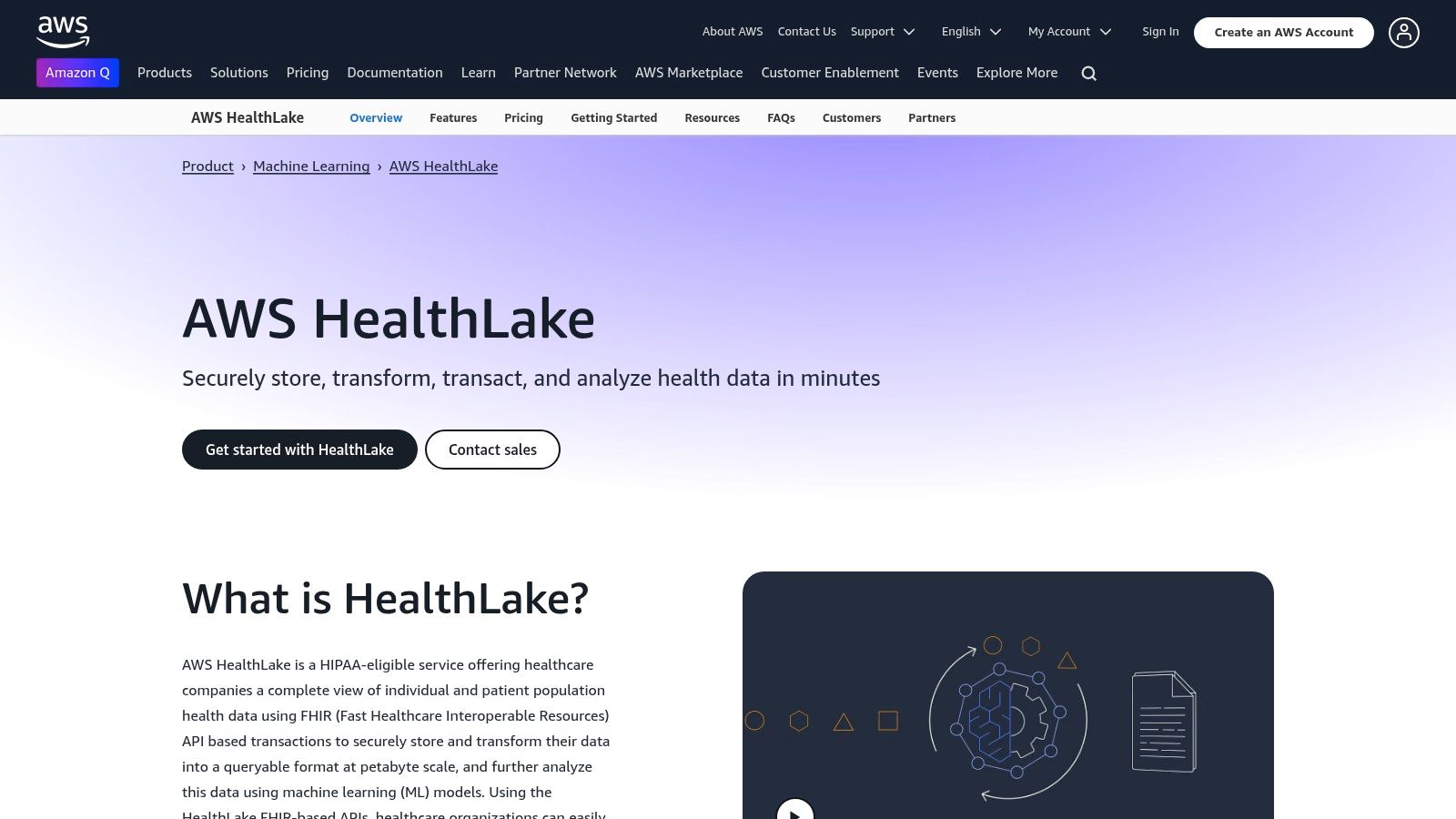
HealthLake's core strength lies in its ability to transform unstructured data, such as clinical notes and lab reports, into structured formats using machine learning. This process allows for easier querying and analysis, enabling healthcare professionals to derive meaningful insights from previously untapped data sources. By adhering to the FHIR (Fast Healthcare Interoperability Resources) R4 standard, HealthLake ensures seamless data exchange between disparate systems, a crucial component of effective healthcare interoperability solutions. This is particularly beneficial for medical device manufacturers, healthcare technology companies, and hospital IT departments looking to integrate their systems with existing healthcare infrastructure.
One of the key features of HealthLake is its natural language processing (NLP) capability. This allows the system to extract key medical information from unstructured text, like doctor's notes and pathology reports, and convert it into a structured format. For medical researchers and scientists, this unlocks the potential for large-scale data analysis, accelerating research and discovery. Academic institutions focusing on medical imaging can leverage HealthLake's scalable architecture to store and analyze vast imaging datasets, facilitating breakthroughs in diagnostic imaging and treatment planning.
HealthLake's scalable data lake architecture allows it to handle the ever-growing volume of healthcare data. This scalability makes it a particularly attractive solution for large hospital systems and research institutions dealing with massive datasets. The pay-as-you-use pricing model also makes it a cost-effective option for organizations of all sizes. For medtech startups and DICOM communication and transfer companies, this flexible pricing model can be especially advantageous, allowing them to scale their usage based on demand.
Furthermore, HealthLake's integration with other AWS services opens up a world of possibilities. Users can leverage AWS's analytics and machine learning tools to gain deeper insights from their healthcare data. This could include predicting patient outcomes, identifying at-risk populations, or optimizing treatment plans. The platform's advanced ML and AI capabilities can be particularly beneficial for developing predictive models for disease progression and personalized medicine.
While Amazon HealthLake offers a robust set of features for achieving healthcare interoperability, it's important to consider the potential drawbacks. Implementing HealthLake requires AWS expertise, and data migration can be complex. Additionally, while the platform boasts strong data analytics features, it offers limited healthcare-specific workflow tools compared to some other solutions on the market. Finally, as with any cloud-based service, there is the potential for vendor lock-in.
Despite these limitations, Amazon HealthLake presents a compelling solution for organizations seeking to enhance healthcare interoperability. Its scalability, advanced analytics capabilities, and adherence to FHIR standards make it a valuable tool for managing and analyzing health data. From streamlining data exchange between hospital systems to powering cutting-edge medical research, HealthLake has the potential to transform the healthcare landscape. For those willing to invest in the necessary expertise and infrastructure, Amazon HealthLake offers a powerful pathway to achieving true healthcare interoperability. You can explore more about Amazon HealthLake on their website.
While pricing is dependent on usage and storage needs, Amazon provides a pricing calculator on their website to help estimate costs. Technical requirements include familiarity with AWS services and data lake architectures. Implementation tips include starting with a pilot project to test the platform and engaging with AWS experts for guidance during the setup and migration process. Compared to other solutions like Google Cloud Healthcare API or Microsoft Azure API for FHIR, Amazon HealthLake offers a more robust data lake architecture and tighter integration with other AWS services, making it a powerful choice for organizations already within the AWS ecosystem. However, organizations heavily invested in other cloud platforms might find those alternatives more seamlessly integrated with their existing infrastructure.
7. Intersystems HealthShare
Intersystems HealthShare is a comprehensive healthcare informatics platform designed to address the growing need for interoperability in the healthcare ecosystem. It empowers organizations to develop, deploy, and manage interoperable healthcare applications, facilitating seamless data exchange and collaboration across the care continuum. This robust platform offers a suite of tools for data integration, analytics, and care coordination, making it a compelling solution for various healthcare stakeholders seeking robust interoperability solutions. HealthShare's focus on a unified approach to data management makes it particularly valuable for complex healthcare environments, allowing organizations to break down data silos and gain a holistic view of patient information.

HealthShare's unified care record functionality aggregates patient data from disparate sources, creating a single, comprehensive view of the patient's medical history. This consolidated record enables clinicians to access critical information quickly, facilitating more informed decision-making and improved patient care. Real-time analytics tools empower organizations to extract actionable insights from their data, identifying trends, optimizing workflows, and improving operational efficiency. Furthermore, HealthShare's clinical workflow automation capabilities streamline administrative tasks and clinical processes, freeing up valuable time for healthcare professionals to focus on patient care. The platform also boasts robust support for multiple healthcare interoperability standards, including HL7, FHIR, and CDA, ensuring seamless data exchange with other systems and promoting broader interoperability within the healthcare landscape. Integrated provider collaboration tools enhance communication and coordination among care teams, further streamlining care delivery.
For medical device manufacturers, HealthShare can facilitate the seamless integration of device data into electronic health records (EHRs), enabling clinicians to access real-time device information within their existing workflows. Healthcare technology companies can leverage HealthShare to develop and deploy interoperable healthcare applications that integrate with existing systems, expanding their market reach and providing more value to their customers. Medical researchers and scientists can utilize the platform's robust analytics capabilities to analyze large datasets, identify patterns, and accelerate research discoveries. Hospital and clinic IT departments can benefit from HealthShare's comprehensive integration capabilities, consolidating disparate systems and streamlining data management processes. Academic institutions focused on medical imaging and medtech startups will find the platform's multi-standard support invaluable for developing innovative imaging solutions and integrating them into existing healthcare infrastructures. DICOM communication and transfer companies can utilize HealthShare to enhance their data exchange capabilities and provide more comprehensive solutions to their clients.
HealthShare’s strengths lie in its comprehensive integration capabilities, strong performance and scalability, extensive healthcare standards support, and robust analytics platform. These features make it a powerful tool for organizations looking to achieve true interoperability. However, potential users should be aware of the high licensing costs, complex implementation process, and the need for specialized technical skills. While HealthShare supports key industry standards, its integration with third-party applications remains somewhat limited, which may require custom integration work in some cases.
While specific pricing details for Intersystems HealthShare aren't publicly available, it typically involves a licensing model based on factors like the size of the organization, the number of users, and the specific modules implemented. Potential users are encouraged to contact Intersystems directly for detailed pricing information and to discuss their specific requirements.
Implementing HealthShare requires careful planning and execution. Organizations should conduct a thorough assessment of their existing IT infrastructure and interoperability needs to ensure a smooth implementation process. Engaging experienced Intersystems consultants or certified partners can be invaluable for navigating the complexities of the implementation and maximizing the platform's potential.
Despite its complexities and cost considerations, HealthShare stands as a powerful healthcare interoperability solution. Its comprehensive features and focus on unified data management make it a worthy investment for organizations committed to achieving true interoperability and unlocking the full potential of their health data. For more detailed information and to explore specific use cases, visit the Intersystems website: https://www.intersystems.com
8. Redox Engine
Connecting disparate healthcare systems is a critical challenge in modern healthcare. Achieving true interoperability requires a robust solution that can bridge the gaps between electronic health records (EHRs), medical devices, and a growing ecosystem of healthcare applications. Redox Engine positions itself as a modern healthcare API platform designed to address this challenge, offering a streamlined approach to healthcare integrations through standardized APIs. This makes it a powerful tool for healthcare technology companies, medical device manufacturers, researchers, and hospital IT departments striving to create connected and efficient healthcare systems.
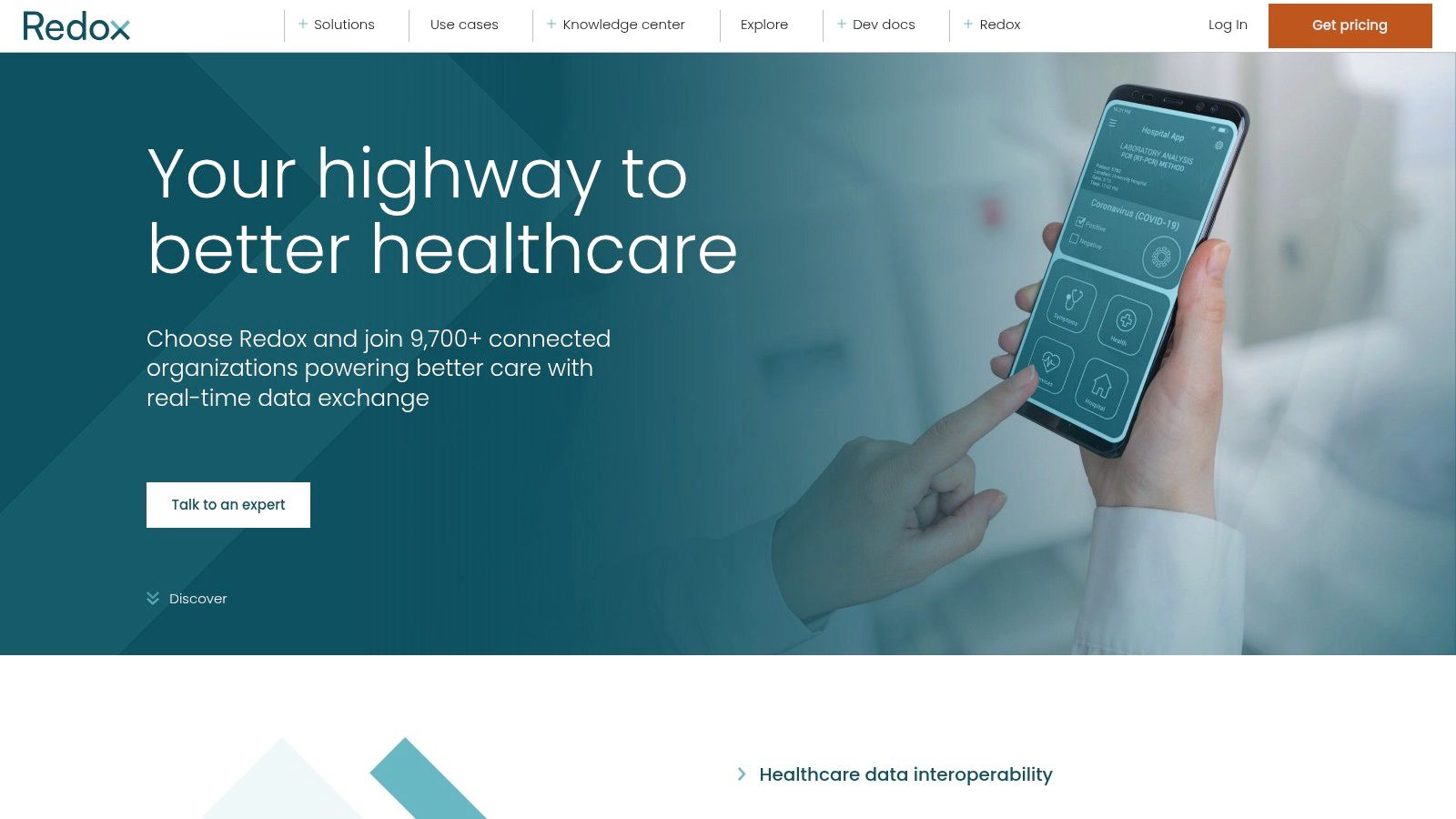
Redox Engine simplifies the complex landscape of healthcare interoperability solutions by providing a single API connection that acts as a universal translator between different systems. Instead of building and maintaining numerous point-to-point interfaces, developers can leverage Redox's API to connect with a wide range of EHR systems and healthcare applications. This EHR-agnostic approach saves valuable development time and resources, allowing organizations to focus on their core competencies rather than complex integration projects.
One of Redox's key strengths is its comprehensive support for industry standards like FHIR (Fast Healthcare Interoperability Resources) and HL7. This ensures data exchange is standardized and secure, facilitating seamless communication between disparate systems. For medical researchers and scientists, this standardized data exchange is crucial for accessing and analyzing large datasets for clinical trials, population health studies, and other research initiatives. Academic institutions focused on medical imaging and medtech startups developing innovative diagnostic tools can leverage Redox to integrate their solutions with existing hospital infrastructure, streamlining data acquisition and analysis. Dicom communication and transfer companies also benefit from the standardized approach, simplifying integration with various PACS (Picture Archiving and Communication Systems) and other imaging systems.
Redox Engine offers several key features that contribute to its value as an interoperability solution. Real-time data synchronization ensures that information flows seamlessly between connected systems, enabling up-to-the-minute access to patient data for improved care coordination. Webhook-based event notifications provide real-time alerts for critical events, such as patient admissions, discharges, and lab results, enabling timely interventions and improved workflow efficiency. Furthermore, Redox prioritizes developer experience with comprehensive documentation, SDKs, and support resources, making it easier for development teams to build and deploy integrations. This developer-focused approach is particularly beneficial for medical device manufacturers and healthcare technology companies seeking to integrate their products with various EHR systems.
While Redox Engine offers significant advantages, there are also some considerations. The platform primarily focuses on API-based integrations, which might not be suitable for all use cases. Organizations relying on legacy systems or specific data exchange protocols might require additional adaptation. Additionally, Redox is a relatively newer player in the market compared to some established integration vendors. While they have demonstrated significant growth and adoption, long-term market stability is always a factor to consider. Finally, utilizing Redox Engine requires development resources. While their simplified approach reduces the overall integration burden, organizations need in-house or outsourced development expertise to implement and maintain the connections. This necessitates ongoing subscription costs, which should be factored into budgetary planning.
Redox Engine's pricing model is generally considered transparent and usage-based. While specific pricing details are available upon request, their tiered structure allows organizations to scale their usage and costs based on their needs. Implementation typically involves collaborating with Redox's team to define integration requirements, configure API connections, and test the integration thoroughly before deployment. Ongoing support and maintenance are provided to ensure the continued smooth operation of the integration.
In comparison to similar tools like Mirth Connect or Interfaceware Iguana, Redox Engine differentiates itself through its modern API-first approach, emphasis on developer experience, and focus on emerging standards like FHIR. While Mirth Connect and Iguana offer a broader range of integration capabilities, including support for legacy protocols, Redox's streamlined API-centric approach simplifies development for modern healthcare applications. Ultimately, the choice between these tools depends on specific organizational needs and technical requirements.
Redox Engine deserves its place in this list of healthcare interoperability solutions due to its innovative approach to simplifying complex integrations. By providing a standardized, API-driven platform, Redox empowers healthcare organizations, technology companies, and researchers to build connected, data-driven systems that improve patient care, accelerate research, and drive innovation in the healthcare industry. For organizations seeking a modern, developer-friendly solution for healthcare interoperability, Redox Engine warrants serious consideration. You can explore their platform further at https://www.redoxengine.com.
Interoperability Solutions Feature Comparison
| Solution | Core Features/Integration ✨ | User Experience & Quality ★★★★☆ | Value Proposition 💰 | Target Audience 👥 | Unique Selling Points 🏆 |
|---|---|---|---|---|---|
| Epic MyChart and Care Everywhere | Real-time data exchange, FHIR R4 API, patient portal | ★★★★☆ Proven, extensive network | 💰 High implementation cost | Large health systems, providers | Extensive EHR integration, strong patient tools |
| Cerner HealtheLife and CommonWell | Multi-vendor aggregation, population health analytics, cloud | ★★★★ Scalable cloud, strong analytics | 💰 Moderate to high, cloud-based | Providers seeking analytics, population health | Broad vendor collaboration, cloud scalable |
| Allscripts dbMotion | Real-time clinical viewer, multi-source aggregation | ★★★★ Proven HIE, comprehensive patient timeline | 💰 Moderate, complex setup | Healthcare orgs needing workflow integration | Vendor-agnostic, clinical workflow focus |
| NextGen Mirth Connect | HL7 FHIR support, multi-protocol connectivity, open-source | ★★★★ Highly customizable, requires technical skills | 💰 Low cost (open-source) | Technical teams, integrators | Open-source, flexible, strong community support |
| Microsoft Cloud for Healthcare | Azure FHIR, AI insights, Teams integration | ★★★★ Enterprise-grade security, integrated ecosystem | 💰 Variable, complex pricing | Enterprises on Microsoft stack | AI+analytics, Microsoft ecosystem integration |
| Amazon HealthLake | FHIR compliance, ML insights, scalable data lake | ★★★★ Highly scalable, strong analytics | 💰 Pay-as-you-use, scalable | AWS users, organizations needing ML | Advanced ML, flexible AWS integrations |
| Intersystems HealthShare | Unified care record, real-time analytics, multi-standard support | ★★★★ Strong performance and scalability | 💰 High licensing cost | Large healthcare orgs, IT teams | Comprehensive integration, strong analytics |
| Redox Engine | EHR-agnostic API, FHIR/HL7 support, real-time sync | ★★★★ Simplifies integration, developer-friendly | 💰 Transparent subscription pricing | Developers, healthcare app vendors | Single API for multiple EHRs, developer-focused |
The Future of Interconnected Healthcare
Choosing the right healthcare interoperability solution is a critical decision. From established players like Epic MyChart and Cerner HealtheLife to innovative platforms like Redox Engine and Amazon HealthLake, the options outlined in this listicle offer a diverse range of functionalities to address varying interoperability needs. Key takeaways include the importance of considering scalability, security, and integration capabilities when evaluating these solutions. Remember to weigh the pros and cons of each platform, paying close attention to how they align with your specific requirements, whether it's robust patient engagement through portals like MyChart and HealtheLife or complex data exchange facilitated by solutions like Mirth Connect and HealthShare.
As healthcare providers increasingly rely on digital solutions, streamlining document collection processes becomes paramount for seamless interoperability. Improving the efficiency of document collection not only enhances workflows but also strengthens relationships with patients and partners. Resources like this guide on how to collect documents efficiently from Superdocu can provide valuable insights into optimizing these crucial processes.
Selecting and implementing healthcare interoperability solutions requires careful planning. Factors such as existing IT infrastructure, budget constraints, and long-term organizational goals should be carefully considered. Furthermore, ongoing training and support are crucial for successful implementation and maximizing the benefits of these powerful tools. Finding the right healthcare interoperability solutions isn't just about improving data exchange; it's about fostering a more connected and patient-centric healthcare ecosystem.
Looking to streamline your DICOM processes and enhance interoperability within your healthcare system? Explore PYCAD, a powerful platform designed to optimize medical image management and facilitate seamless data exchange. Visit PYCAD today to discover how it can revolutionize your interoperability workflows.
